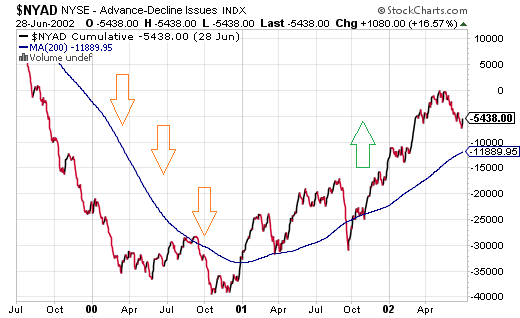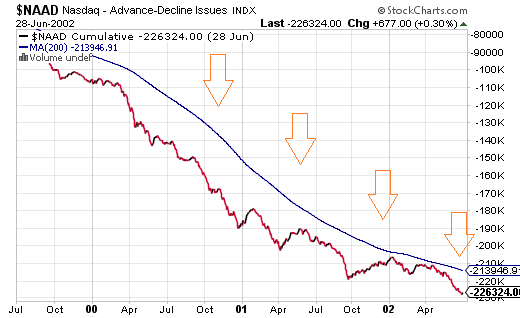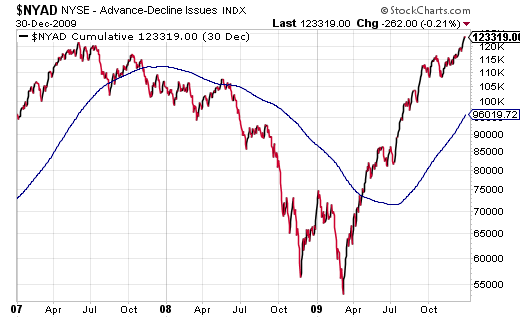Recently, I was speaking with one of the co-founders of the popular exchange-traded fund web site, ETF Database. He wanted to get my thoughts about the problems with “buy-n-hold.” I did not hesitate to give him an earful.
Rather than chronicle my conversation in its entirety, or reiterate my commentary from dozens of previous articles on the topic, readers may wish to contemplate the risk of holding onto a permanent portfolio at this moment. Indeed, the risk of hold-n-hope at a time when valuation levels are extreme and market internals are sketchy is a recipe for disaster.
For instance, assume that your approach to investing is to hold 80%, 90% or 100% in U.S. stocks for the next 30 years. Your reasoning? Stocks are extremely unlikely to lose value over a 10-year span, let alone a 30-year period. Unfortunately, at this particular juncture in the bull market cycle, current stock valuations suggest that it is quite possible, if not probable, that the asset class will lose HALF of its value in the next bear market.
Why is it worth considering 50% depreciation in stock prices? It happened in 2000. It happened in 2007. And the recent extremes in the median price-earnings ratios (P/E) and median price-sales ratios (P/S) actually went beyond the peaks hit in 2000 and in 2007.
What happens, then, if your portfolio is worth HALF of what it was worth at the bull market top. If you are fortunate enough to witness an 8-year bull market compounding at 9% from the bearish bottom, you will only find yourself back at the starting gate. Even Steven. And that’s after realizing a remarkable 9% compounded for eight years!
Keep in mind, the break-even scenario described above also implies that one never wavered on the hold-n-hope approach. You never once panicked. You never once sold. You never came to the conclusion at any point that the return of your principal was more important to you than the return on your principal.
Eight years. Same dollars in your accounts, though they would have less purchasing power due to inflation. Heck, at that time, people will be thinking about who they might like to replace President Hillary Clinton as she is rounding the bases of her second term. (That’s not a prediction… just an effort at some humor.)
In contrast, tactical shifts designed to reduce risk when valuations are extreme and market internals are weakening can lessen the adverse impact of bearish catastrophes. An individual who loses HALF of his/her account value needs 100% to recover. The individual who only loses 20% requires 25% to be made whole. If that takes a year or two or even three, the individual would have 60 more months in the hypothetical 8-year bull cycle to grow his/her account value substantially.
Hold-n-hope advocates disparage the notion that one can reduce exposure to riskier assets (or raise them) in a manner that might prove successful. Doing so, they claim, amounts to little more than sporadic market timing. That is incorrect. Had one simply used extreme valuations alongside deteriorating market internals to reduce exposure to U.S. stocks in 2000 and 2007, they’d have preserved more of their account values for enhanced long-term compounded growth.
Consider valuations at the start of the year 2000. The trailing twelve month P/E (34.0) and trailing 10 year P/E (44.2) for the S&P 500 had been hitting never-before-seen extremes in history. In the same vein, the New York Stock Exchange Advance Decline (A/D) line was buckling at an increasingly rapid pace; the downward slope of its 200-day moving average indicated fewer and fewer participants in the “New Economy” bull.
The deterioration in market breadth coupled with extreme overvaluation prior to the March 2000 bearish beginnings provided ample opportunity for investors to lower risk exposure. What’s more, since the improvement that occurred for the NYSE A/D line in the broader stock market in 2001 as well as 2002 was not accompanied by improvement in the NASDAQ A/D Line – and since there was little improvement in fundamental value – maintaining a lower risk profile for longer was warranted.
Now let’s turn our focus to the year 2007. By the middle of that year, the trailing twelve month P/E (20.0) and trailing 10-year P/E (27.3) had been signaling caution. A wide variety of other valuation methodologies were also indicating a severely overpriced backdrop. As if that weren’t enough, the NYSE A/D Line began showing significant and persistence weakness as 2008 had been getting underway. Not paying attention to the breakdown resulted in unnecessary pain for investors.
Again, a breakdown in market breadth accompanied by highly overvalued equity prices should be met with a decision to reduce one’s risk exposure. One does not have to short the market or seek to eliminate risk entirely. However, it is sensible to insure against the possibility of monstrous loss. What’s more, when improving market internals occur in conjunction with more favorable stock valuations – as they did in 2002 and 2009 – one can rebalance back to a target allocation.
So what are the circumstances for today’s valuations and today’s market internals? Not so hot.
As I mentioned earlier, the median price-earnings ratios (P/E) and price-sales ratios (P/S) actually surmounted the peaks at the end of the last two bull market cycles – the metrics went beyond the valuation peaks hit in 2000 and in 2007. Corporate earnings have now fallen from a height of $106 in 2014 to current levels of $95.4 on the S&P 500 for a 10% decline. They’ve fallen for two consecutive quarters and they are expected to fall in Q4 in what has been dubbed an “earnings recession.” The trailing 12-month P/E Ratio is 22.7, while the average since 1870 is 16.6. Meanwhile, the PE10 at 26 sits in highest quintile, implying that equities are severely overpriced.
What about forward 12 month P/Es? Aren’t they still attractive? Although this “guestimate” methodology did little to help folks avoid the staggering losses of 2000 and 2007, the forward P/E of 17.2 right now is higher than it was in 2007 and it is well above the Goldman Sachs (N:GS) 35-year average (13.0).
Naturally, perma-bulls and buy-n-hold advocates alike have endeavored to paint a prettier picture. Just exclude energy from earnings per share. For that matter, exclude corporations with 50% or more of their profits coming from overseas, and the earnings picture brightens considerably.
Now how silly is the mistake of “Ex energy” or “Ex foreign exposure?” That’s akin to tossing the double-digit earnings expansion of the health care sector because the results are too wonderful. That’s about as sensible as removing the positive contributions from the consumer discretionary sector, since the savings at the pump have presumably gone into spending online or eating at restaurants or purchases at the auto mall.
Conjuring up “Ex energy” is like putting lipstick on an elderly pig or providing a face lift for an aging dog. (Yes… those politically incorrect references.) Remember, “Ex-tech” discussions were floating around in 2000. “Ex-financials” were popular with analysts in 2007. If you’re going to argue “Ex energy” earnings per share today, then you should have ran with this line of thinking when crude traded north of $105 per barrel.
Bottom line? It is true that valuations only carry weight when stock tailwinds turn to stock tornadoes; it is accurate than decidedly overpriced equities could thrive until they become insanely priced. Nevertheless, booms become busts and the current bull cycle is no different.
It follows that preparing for a bust involves monitoring the forces that drive valuations as well as monitoring market internals. For instance, we know that ultra-low borrowing costs over the last seven years have fueled everything from consumer purchasing activity to mortgage refinancing to real estate speculation to corporate share buybacks. The question an astute investor may wish to pursue is whether or not corporations will even be positioned to take on more debt to buy back their shares going forward. Total corporate debt has more than DOUBLED since pre-crisis levels of 2007, while the average interest paid on debt for corporations has jumped from 3.5% in 2007 to 4.5%.



